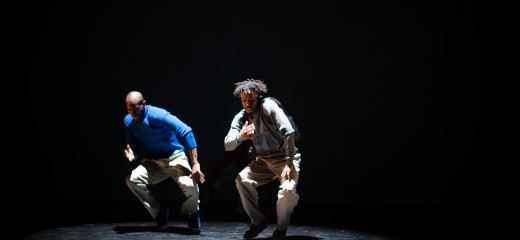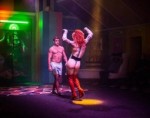
The Evolution of Success
by Whitney Weinstein
“Now is only now.” —Raphael Xavier, The Unofficial Guide to Audience Watching Performance
How do we continually accept and understand the human body, where time seems the antagonist? Is there a way for an artist who relies heavily on physical strengths to transition into a new realm where both realistic and creative expectations can be adequately negotiated?
In The Unofficial Guide to Audience Watching Performance, Xavier presents an autobiographical dance-theater work that bridges street performance and more formalized concert art. He begins the fifty-minute piece by explaining to the “class”—the crowded, wide-eyed audience—that he will be substitute teaching for Mr. Reynolds. He reads the class announcements and the daily quote: “No thing can exist without nothing.”
He describes the class’s lesson, cultural transmission, as “the way a group of people tend to learn and pass on information…. It’s about being in the moment. Let me show you how.” Through narrated movement sequences and impressive breakdancing skills, Xavier shows the crowd his here-and-now. Cultural meanings and significance are passed on from older generations to the new teachers of our world.
Artists across many fields turn to teaching, dispensing knowledge from their own education and lively careers to up-and-coming creators with eager minds. Teaching can be humbling work; it can also be rewarding. And teachers can inspire. I can recall some of my own mentors who steered me towards new perspectives and artistic revelations. I can also recall instructors who seemed pressured into that role and carried their angst into the classroom. Xavier’s Unofficial Guide reflects his shift into a different stage of his career, a move forced by the passing of time. The program states that, “when vulnerability and creativity meet, there is potential for a masterpiece.” Xavier teaches the audience from his own life lessons.
Three characters inhabit this performance—all reflections of Xavier at different times in his life. The current-day Xavier plays the role of a teacher, and two younger performers dance the roles of an adolescent and teen, students in the school. The fast tempo of their movements make the moments where they sustain poses, or freezes, seem like stopped time. The near-constant circling and the way the dancers follow their momentum—to and from the floor, spinning on their backs, rearranging formations—is hypnotizing. Without hesitation the three breakdancers shift in and out of the spotlight, sometimes to steal it, other times to share it. They mirror each other, expressing a desire to understand or perhaps even empathize. Quick, light, and intricate, they reshape head spins into windmills, their legs extending into space.
The program explains, “all [characters] relate to each other in the dance and the story—as individuals, then as peers, and eventually connecting as one.” The note is unnecessary; this evolution becomes visible as the performers interact onstage. Every moment deepens my understanding of each character. Xavier further explains that the role of the audience is not only to watch, but also to be watched. “I wanted to create … a truth and give it to the world”—a world constituted by Xavier’s audience. The awareness of perceiving and being perceived creates reality.
As Xavier repeatedly returns to a small chalkboard lying in the center of the floor to frantically scribble, I sense his restlessness and frustration. By the end, that agitation transforms into Xavier’s acceptance of the ephemerality of his purpose, and a desire to maintain active curiosity about his work throughout a lifetime. With vitality and steadiness, in The Unofficial Guide to Audience Watching Performance, Xavier seeks to discover peace in his modified role as an artist within the community and within himself. He tells the audience, “embrace it and thereby become it.” There are no great teachers without hard-won experience. There is no meaning without content, no individual evolution without reflection. Fighting time is a lost battle. Most importantly, every moment’s encounter informs and enhances the next, provided that the individual chooses to live in the now.
The Unofficial Guide to Audience Watching Performance, Raphael Xavier, FringeArts, February 11-13, http://fringearts.com/event/unofficial-guide-to-audience-watching-performance/2016-02-11
By Whitney Weinstein
March 2, 2016







